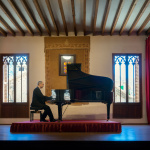The old Cartoixa de Valldemossa (Palace of King Sancho)
The old Cartoixa de Valldemossa (Palace of King Sancho)
James II, first monarch of the private kingdom of Mallorca, had this building built in 1309 as a residence for his son Sancho to find relief from his asthma disease. It is believed that he built it on an old fortress of a Moorish vali: Mussa, from which the name of Valldemossa would come.
In 1399, King Martin I of Aragon, called "the Human", ceded all the royal possessions of Valldemossa to the Carthusian friars. They founded the Charterhouse and transformed the main square into a cloister and cemetery, the five halls that were in cells, the prison into a refectory, the pantry into a sacristy and the kitchen into a church.
In 1835 it passed into private hands due to the confiscation of Mendizábal, which consisted of putting on the market, through public auction, the lands and non-productive assets of the church or religious orders, in order to increase the national wealth and create a bourgeoisie and middle class of owner farmers.
It is one of the most emblematic places of Valldemossa; since its construction, in 1309, it has become the scene of some of the most outstanding historical episodes of this Mallorcan municipality. Therefore, we offer you a list of curiosities that allow us to know, more and better, the immense heritage value of the Palace of King Sancho.
James II of Mallorca would order the building to be erected in Valldemossa to house his son, Sancho I, who suffered from asthma. The temperature and humidity of the area reduced the symptoms of his disease.
Different members of that Mallorcan royalty shared their passion for hunting: the location of the palace was perfect to be able to carry out this practice in places like the Moleta de Pastorix, na Torta, the Puig des Boixos or the same skirt of the Teix.
As a preventive measure, the Palace of King Sancho had a dungeon in its eastern part that, later, with the arrival of the Carthusian monks, would become a refectory.
As a preventive measure, the Palace of King Sancho had a dungeon in its eastern part that, later, with the arrival of the Carthusian monks, would become a refectory.
In 1394, the Palau would for a brief period of time become the residence of John I of Aragon. He arrived along with his family and his court, including poets, jesters and troubadours, fleeing the plague that struck Europe.
When the building was disused, the father general of the Order of San Bruno, Guillermo Reynaldo, based in Grenoble (France), proposed to Martin I the refoundation of the space as a Carthusian monastery. On August 11, 1399, his first Mass would be celebrated.
The old parade ground of the Palace was converted into a small cemetery for monks; around it, a first Gothic cloister was mounted of which there is no longer any vestige, but of which we have knowledge thanks to the drawings and descriptions of foreign travelers, such as the Frenchman Joseph B. Laurens.
In 1835 the process of ecclesiastical confiscation began, promoted by Minister Mendizábal to solve the financial situation of Spain: it would represent the definitive exclaustration of the Carthusian monks.
Since the nineteenth century, the building would be in the hands of different private owners, highlighting the marriage formed by Joan Sureda and Pilar Montaner, in charge of hosting a whole series of renowned cultural figures: Miguel de Unamuno, Rubén Darío, Azorín or Santiago Rusiñol, among others.
Inside the Palace of King Sancho there is a set of paintings by Ricardo Anckermann (1842-1907), disciple of Fausto Morell, in which different scenes from the history of Valldemossa are reproduced.







